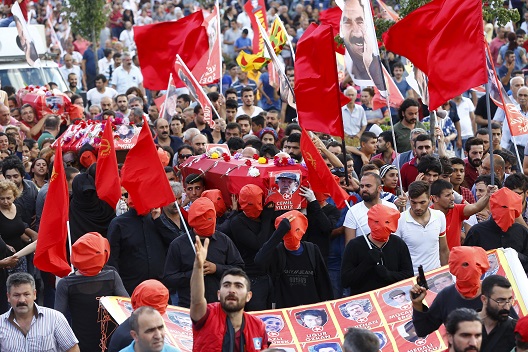 On Tuesday July 20, Şeyh Abdurrahman Alagöz allegedly detonated a suicide vest in the Kurdish majority town of Suruç, killing thirty-two members of a leftist organization linked to the Socialist Party of the Oppressed (ESP). The attack took place just days after representatives from Turkey’s Kurdish majority Peoples’ Democratic Party (HDP) and its regional sister party, the Democratic Region Party (DBP), gathered in Suruç to celebrate the third anniversary of the founding of Rojava—the Kurdish name for the Kurdish-controlled cantons in neighboring Syria.
On Tuesday July 20, Şeyh Abdurrahman Alagöz allegedly detonated a suicide vest in the Kurdish majority town of Suruç, killing thirty-two members of a leftist organization linked to the Socialist Party of the Oppressed (ESP). The attack took place just days after representatives from Turkey’s Kurdish majority Peoples’ Democratic Party (HDP) and its regional sister party, the Democratic Region Party (DBP), gathered in Suruç to celebrate the third anniversary of the founding of Rojava—the Kurdish name for the Kurdish-controlled cantons in neighboring Syria.
The HDP/DBP linked Democratic Union Party (PYD) govern Rojava. The PYD is linked to the Kurdistan Workers’ Party (PKK), the armed insurgent group formally designated by the United States and others a terrorist organization, which has battled the Turkish state since 1984 for greater political autonomy, if not outright secession. The HDP has links to the ESP group attacked at Suruç; for example, HDP co-chair Figen Yüksekdağ had led the ESP prior to the establishment of the HDP. This latest bombing is the third major attack against an HDP target since May and bears similarities to the June 5 attack against an HDP election rally.
These attacks have exacerbated the growing Turkish-Kurdish tensions and violence in much of Turkey’s southeast and underscore the spillover effects of the Syrian civil war. They also point to a much broader security problem: as the war in Syria intensifies, Turkish fighters—including the two who bombed Kurdish targets in Diyabakır and Suruç—have returned to Turkey.
Alleged June 5 Diyabakır bomber Orhan Gönder reportedly travelled to Syria to join the Islamic State (ISIS or ISIL). Gönder and Alagöz’s stories are similar to that of other Turkish ISIS fighters, who heretofore have faced no official obstacles in crossing the Turkish-Syrian in both directions. Some left the caliphate for months, grown disillusioned, and returned to Syria to fight with ISIS.
Gönder and Alagöz both hail from Adıyaman, a city with a large Kurdish population. Şeyh’s brother, Yunus Alagöz, reportedly opened a tea/prayer house in the city in 2014. This location doubled as an illegal mosque and ISIS recruitment center. As early as 2013, residents from Adıyaman had complained to authorities of young people joining Jabhat al Nusra, which at that time was battling the PYD’s militia, the YPG, in and around the town of Tel Abyad. Many of these Nusra brigades subsequently pledged allegiance to ISIS after the two groups split that same year. This period also marked the beginning of near-weekly funerals in many Kurdish villages in Turkey’s southeast, often attended by DBP/HDP politicians, for PYD fighters (including the sons and daughters of elected officials) killed in battles inside Syria.
That Gönder and Alagöz are both ethnic Kurds demonstrates the cross-ethnic appeal of ISIS. Gönder a Bektaşi Alevi, as was another unidentified ISIS fighter, reported by Birgun newspaper, (which takes a strongly secularist opposition line vs. the AKP Government) using his initials C.A., from Hacibayram, Ankara—a well-known ISIS stronghold. C.A.’s published story traces the easy access along Turkey’s border, which ISIS recruits have exploited. In a Turkish version of the interview, C.A. recounted joining ISIS in 2014 before leaving the group and crossing back to Turkey a few months later. The admitted drug addict relapsed after coming home to Ankara, a possible motivating factor in his decision to return to Syria in March 2015 before growing disillusioned again and returning to Turkey in late June.
Turkey’s intelligence services arrested and interrogated him during the month of his arrival, but they promptly released him pending trial, specifically under the provisions of Turkey’s generous repentance laws, designed to encourage defection from the PKK. Just two days before his attack in Diyabakır, Turkish police also detained and questioned Gönder over the status of his military service. (Authorities evidently were unaware of his links to ISIS.) Anecdotal evidence suggests that the local police have no regular access to other Turkish agencies’ information about returning ISIS fighters. Nonetheless, the report does quote C.A.’s observation from Ankara that the police presence in Hacibayram has increased in recent weeks.
A fourth Turkish ISIS fighter, Raşid Tuğral, crossed the border into Syria in early January 2015. Unlike when C.A. first crossed in 2014, Tuğral took the precaution of crossing at night and at a sparsely guarded stretch. Tuğral described the difficult conditions in Syria in an online journal on Facebook. He also described how ISIS organizes Turkish and Azeri fighters together for training and military operations.
A Turkish imam would give Turkish/Azeri units spiritual guidance about behaving as a “proper Muslim.” He described a fierce debate among Turkish ISIS fighters about whether to extend the war into Turkey. Tuğral wrote that the group was split about attacking Turkish targets: many argued that Turkey is “friendly” and should not be provoked, while others claimed that AKP members are apostates and impious. The imam warned against attacking Turkey, echoing C.A.’s claims that ISIS avoids antagonizing Turkey, for fear of Turkey enacting a more restrictive border policy.
Tuğral and C.A. each expressed growing anxiety within ISIS about US airstrikes and Kurdish advances in ISIS-held territory in Syria. The turning point, it seems, came during the September/October 2014 battle for Kobane, where intensified US bombing ultimately helped the YPG expand its territory. During the battle, a large contingent of Turkish Kurds fought with ISIS against Turkish Kurds with YPG. The largest Turkish/Azeri speaking brigade, Cundullah Jamaat suffered heavy casualties during the battle. In the battle’s aftermath, an Eastern European woman, reportedly married to a killed ISIS fighter, blew herself up at a small police station in Sultanahmet in a crude suicide attack.
The Kobane battle also exacerbated tensions between Kurdish nationalists and Islamists, which had existed for decades. In October 2014, the PKK’s youth group, the YDG-H, began to target members of Huda Par (a civilian wing of Kurdish Hezbollah, an Islamist Kurdish faction that many accuse the Turkish state of creating during the 1990s to attack the PKK) in cities throughout Turkey. These low-level clashes erupted after the HDP called for its supporters to take to the streets to protest the AKP’s perceived indifference to the plight of Syrian Kurds battling ISIS in Kobane. These protests devolved into continued violent clashes between the two groups and resulted in some fifty deaths.
These Turkish Kurdish-Islamist tensions mirror those in Syria. The Huda-Par leadership has indirect links to well-known supporters of Jabhat al-Nusra, some of whom were arrested during a recent anti-jihadist crackdown aimed at breaking up ISIS networks inside Turkey. Turkish language pro-jihadist media lambasted the arrests as an attack on Muslims, while ISIS’s official Turkish language publication, Konstantiniyye, accused the AKP of working to establish a Kurdish state inside Syria and denied any links to the Turkish government.
Whatever the truth, most of Turkey’s Kurds—including the leadership of the HDP—believe that the AKP and Huda Par are working together to support ISIS to battle the PYD in Syria. Hence, a large plurality of Turkey’s Kurds have blamed the AKP for the Suruç bombing attack. This claim builds on these years of tensions. It also draws popular credence among Kurds from the well-publicized fact that suspected ISIS fighters have faced little punishment—and are often released without charge—for travelling to Syria, whereas Kurds are often incarcerated and prosecuted for suspected links to the PKK. These tensions have grown even more acute in recent days: the PKK killed two police officers in Urfa as revenge for the Suruç bombing. The YDG-H has also responded, killing two men they claim—without evidence—are members of ISIS.
These tensions and popular perceptions notwithstanding, the ISIS leadership would not likely have planned or ordered the Suruç attack. ISIS has yet to take credit for the bombing, an oddity considering the group’s announcements after suicide bombings in Gulf countries designed to foment sectarian tensions between Sunni and Shia. Şeyh Alagöz—perhaps with his still-missing brother, Yunus—may have planned this attack independently and chose a convenient target near his hometown. Alternatively, ISIS could be acting strategically, playing down its potential involvement, for fear of a harsher crackdown by Turkey.
Turkey still faces a considerable threat from ISIS. On July 23, shots fired from ISIS-held territory in Syria killed one Turkish army officer and wounded another, prompting a response from artillery units deployed along the border. Yet, beyond the threat of ISIS inside Syria, the details about Alagöz suggest a longer-term challenge from Turkish fighters or ISIS sympathizers returning from the front lines or radicalized at home. These men have demonstrated the capability to strike Kurdish targets, contributing to the breakdown in negotiations toward a peaceful settlement between Turkey and imprisoned PKK leader Abdullah Öcalan. These ongoing Kurd-on-Kurd clashes and the tensions between Turkish Kurdish communities and the government underscore the complexity of the security problem Ankara now faces and the ways in which the Syrian conflict has spilled over the border.
This spillover of the Syrian civil war affects Turkey’s consideration whether to open Incirlik Air Base for US strikes on ISIS. The Wall Street Journal has reported that Turkey has agreed to open the base, after Presidents Obama and Erdogan agreed to step-up joint cooperation against the extremist group. Regardless of the extent to which the Turkish government may overtly support the Western-Arab coalition’s military action against ISIS—and regardless of the impact of such support against ISIS—Turkey will have to deal with ISIS sympathizers and returning fighters for years. The attacks at Diyarbakır, Suruç, and Urfa show that the presence of such returnees and the security threat that they pose will directly affect Kurdish-Turkish relations. These dynamics are certain to continue, suggesting continued security threats for Turkey stemming from the Syrian civil war for the years to come and a baneful detour from the once-hopeful negotiations process between the AKP government and the PKK towards ending the latter’s “armed struggle”—and its domestic and international status as a terrorist group.
Aaron Stein is a Nonresident Fellow with the Rafik Hariri Center for the Middle East, a Doctoral Fellow at the Geneva Center for Security Policy, and an Associate Fellow at the Royal United Services Institute in London.
Image: Masked men carry the coffins of a victim of Monday's bomb attack in Suruc, during a funeral ceremony in Istanbul, Turkey, July 22, 2015. A suspected Islamic State suicide bomber killed at least 30 people, mostly young students, in an attack on the Turkish town of Suruc near the Syrian border on Monday. (Reuters)

